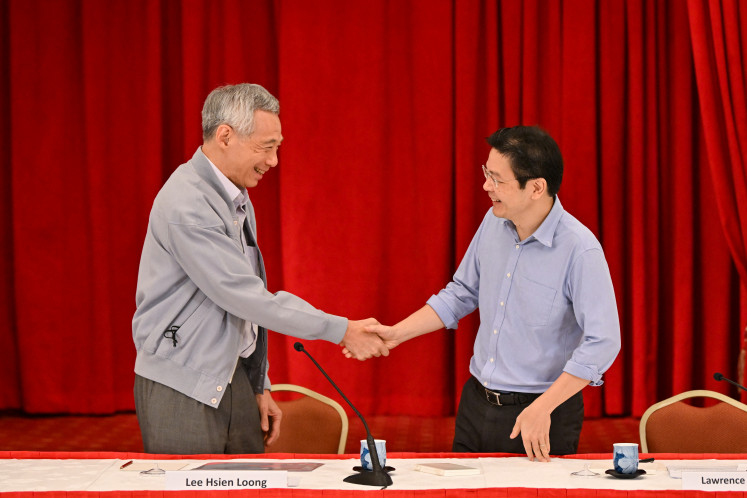Gearing up to end the overlooked killer
While global tuberculosis (TB) rates have been declining, Indonesia remains among the top five TB countries
Change Size

W
hile global tuberculosis (TB) rates have been declining, Indonesia remains among the top five TB countries. Annually, half a million Indonesian people develop TB and 68,000 die, making it the second leading cause of death nationwide.
In conjunction with TB Day on March 24, the World Health Organization (WHO) is once again calling for commitments and actions to reach and treat every TB patient.
In 2013, only 71 percent of estimated TB cases in Indonesia were recorded. Furthermore, among the estimated 6,800 people with multi-drug resistant (MDR) TB, only 13 percent were accounted for.
The rest are either not reported or undiagnosed. This is a danger to public health. Each untreated TB patient can infect up to 10 people a year, while the missed MDR TB cases pose a greater threat of infecting the community with resistant strains of TB.
The national TB program (NTP) has to find a way of improving TB case notifications. Otherwise, this ongoing massive number of fully preventable deaths will not come to an end.
The improvement in drug supply chains and the supportive role of medicine intake observer (PMO) contributes to the treatment success rate, which continues to be high at 86 percent since 2005.
Following the WHO recommendation, the NTP has strengthened laboratory capacity as more and more laboratories are now using GeneXpert MTB/RIF as the initial diagnostic test for people at risk of MDR TB and for people living with human immunodeficiency virus (HIV).
More can be done. The NTP needs to dedicate resources toward targeting the previously unreached populations. The current standard of one TB health worker for each primary healthcare facility is suboptimal.
It will count for only about 20.5 percent of the ideal TB patient-worker ratio, as indicated by Prof. Niyi Awofeso from the School of Public Health at the University of Western Australia: one TB nurse per 12 patients. Once the NTP conducts a resource calculation to cover the large population of TB patients, we will then be able to capture and address those who are missed.
However, more workers won't necessarily solve the problem. Most TB health workers claim that their salary is not it for the workload, according to a recent study in Semarang.
This may cause them to work ineffectively, as they sacrifice performance to do a second job part-time. So, in order for them to be more motivated in case detection, the NTP should promote performance-based incentives.
In Bangladesh, the rural committee includes patient deposit-provider incentives in TB management. Within a year, the case detection rate improved to 68 percent from 44 percent.
Similarly, Chinese community health workers receive a fee for every new TB patient enrolled in treatment, another when the patient comes for a two-month treatment follow-up and a third when the patient completes treatment.
This case-finding payment contributes to increasing China's levels of case detection as well as treatment adherence.
Directing incentives and enablers for the patients will also create even more boosts to completion of TB treatment. Following the incentive program for patients with uninterrupted treatments, the default rate in Russia drops from 15 to 20 percent to 2 to 6 percent.
Mutual trust, respect and effective communication between patient and health worker are key supplements for this approach to work.
To make sure both private and public sectors contribute to TB case notifications, we should insist on a public-private mix (PPM)-wide strategic plan ' not just for the directly observed treatment strategy's enhancement in private healthcare facilities, but also for gathering private health workers to find TB patients by using the incentive-based system.
This scheme was established in Pakistan and, after a year, doubled its case notifications. In Indonesia, the success is increasingly important as currently 40 percent of healthcare is provided through the private sector and the national survey finds that 63.89 percent of TB patients seek care at hospitals and private practice physicians.
While the NTP has continued to grow, our investments have not kept pace. Based on the latest financial report, the current level of funding is at least US$72.39 million less than what we need to effectively operate the NTP.
The government should view this gap as an investment opportunity, not as an expenditure. Increasing the number of TB cases found and treatments is clearly cost-effective.
David Collins, senior health finance advisor from Management Sciences for Health, calculates that the government investing an additional $35 million in TB and MDR TB would have a 40 percent reduction of productivity loss, disability and premature deaths and save an overall $800 million. In other words, it pays for itself.
Government, through the NTP, is and should remain a vital leader in fighting against TB and closing the gap on missed patients.
The strategy will require advances in human resource systems, sustained funding and reinforcements from contributing communities, as well as all healthcare sectors.
Enabling high-quality TB access and treatment for everyone can surely make us leaders in the world, to be free of TB with no deaths, illness or suffering.
______________________
Novita Gemalasari Liman is a physician in Barru and a research associate at Suharlim Foundation. Christian Suharlim is a post-doctoral researcher at Harvard Center for Health Decision Science and a former employee at Health Ministry.









